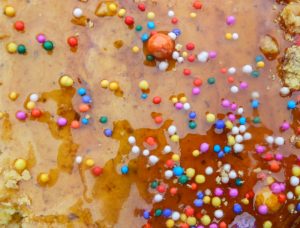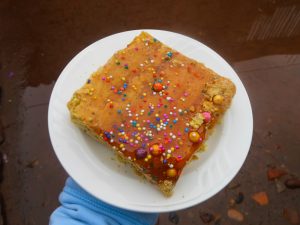Doña Pepa’s Turrón Accompanies the Lord of Miracles this Month

Just like every year, in Lima and wherever there are Peruvians we celebrate when the Lord of Miracles comes out of his temple. The devout from all over come to Lima, especially, or wherever there is an image of him, to pray for their loved ones. They plea for them to be healed from the sickness that afflict them and they ask for the success of future projects. The devout also sweeten their palates with the majestic turrón of Doña Pepa. This dessert rules throughout Lima. It decorates the city with the thousands of colors of the small candies on its top.
Doña Pepa’s Turrón is a traditional sweet deeply related to the feast of the Lord of Miracles. It is made of a number of compact and crispy logs made from flour and eggs. Flavored by aniseed they are woven together and bathed in layer after layer of thick molasses syrup and fig leaves. These make the entire concoction very compact and eliminate air spaces. In order to have even more flavor, the entire surface is covered with extra syrup and the turrón is covered with brightly colored sugar balls and sparkles of different shapes, form, and sizes.
The turrón is a classic Spanish sweet that came to the new world and took this form in Lima. History attributes the invention of this particular turrón to the slave Josefa Mamanillo who lived in the Cañete River valley. An extraordinary cook, she obtained eternal fame with this dessert. There are two stories in which the principal heroine is this slave.

The first relates how Josefa Marmanillo began to suffer a paralysis in her arms. This sickness made it possible for her to be freed from slavery. But at the same time, by blocking her ability to work, it left her without the ability to sustain herself.
Given her circumstances, she paid attention to the rumors about the miracles that the image of the Christ of Pachacamilla performed. She traveled to Lima and her faith and devotion were so great that the Lord helped her recover from her infirmity.

In gratitude to this image of Christ she created a sweet dedicated to the Christ of Pachacamilla, now called the Lord of Miracles.
The next time he left his temple in procession, Josefa brought out the turrón as an offering to him. On her return to Cañete, she assured everyone that the Christ had smiled at her while he blessed her offering. In following years she returned to Lim for the processions of the Lord and sold her dessert to his faithful. Her daughter and granddaughter, s well as later generations, continued the tradition.
The second story holds that a Viceroy organized a contest to reward the person who made a pleasing and nourishing food that could be preserved over various days. The winner was Josefa Marmanillo. As a result, she was called “Doña Pepa” and became eternally associated with the dessert.

Doña Pepa’s Turrón
Ingredients:
Dough:
2 kilos de self-rise flour
12 egg yolks
1 egg white
1 1/3 cups brewed anise tea
2 or 3 drops yellow coloring
450 grams butter
450 grams de lard (or vegetable shortening)
1 teaspoon of salt
2 tablespoons aniseed, ground in a mortar
2 teaspoons of well toasted sesame seeds
Syrup:
3 balls chancaca
4 cups of water
2 tablespoons of pectin or glucose
4 teaspoons of good wine vinegar
6 quinces in slices with peel and seeds
2 oranges cut into eight pieces with the peel and seeds
Stick cinnamon
2 tablespoons aniseed
1 fig leaf
Sparkles and colored sugar balls of different sizes for decoration.
Preparation:
Dough:
Sift the prepared flour. Add the lard and the butter together. Little by little add the anis tea with warm water, salt, the coloring, sesame seeds, and the ground aniseed. Knead it all together, from the center to the sides. Finally add the egg yolks and the egg white.
Once the dough no longer sticks to your hands, form balls and let it dry in the air a bit. If you dip each ball in flour it will dry faster.
Then knead it again. This time let it rest for one hour at least. Make balls. From them, shape logs that are long and thin. Place them on a cookie sheet leaving space between them. Heat an oven to a high temperature and then reduce it to 180º C and bake for 15 minutes. Place the first layer of logs on wax paper once baked.
Syrup:
In a pot place all the ingredients (except the vinegar) and heat over medium flame without stirring until it thickens (reaches a state called “a punto de caramelo”) and then add the vinegar. When the syrup is ready pass it through a sieve.
Assembly:
On wax paper lay down a first layer of logs one next to the other. Then you add a thick layer of syrup on top of the logs in a vertical layer. Add another layer of logs in a horizontal fashion, then syrup on top of it, followed by another layer of logs laid out vertically and then syrup. You continue this until you reach the height desired for the turrón. Make sure that the last layer is syrup. On top of the turrón you add colored sugar balls in different sizes, sparkles, and so on.
This recipe yields 2-½ kg of turrón.




